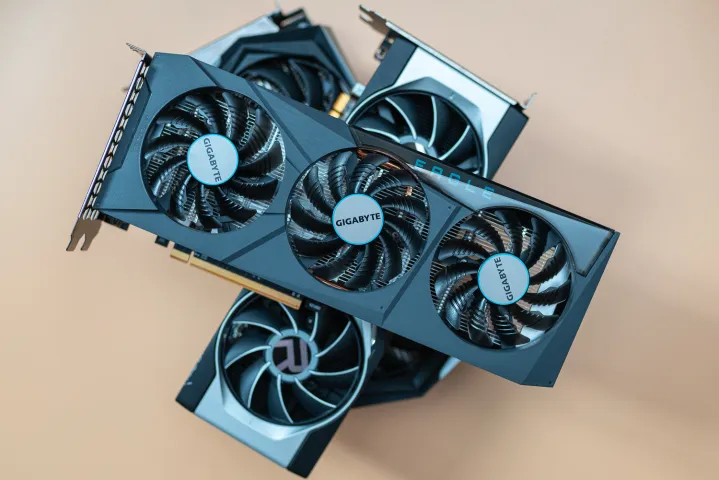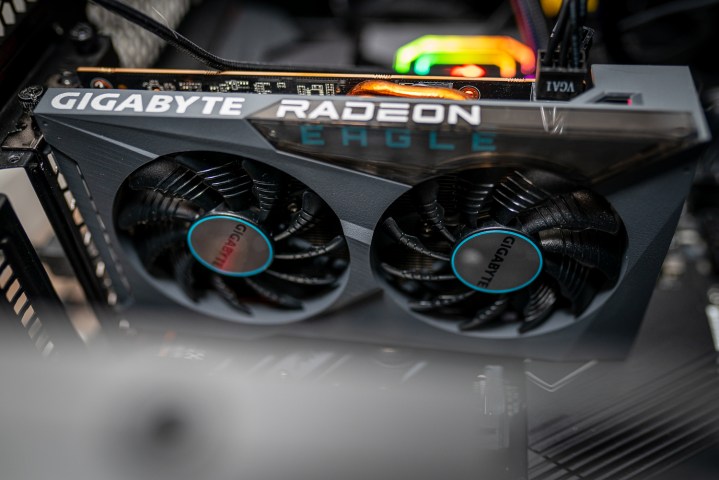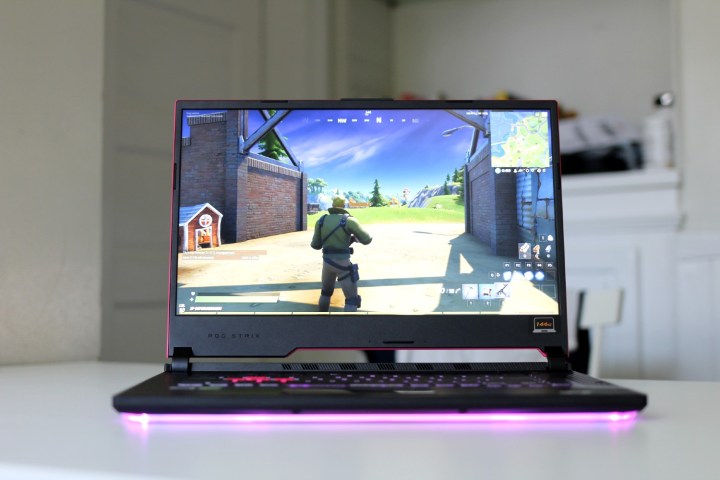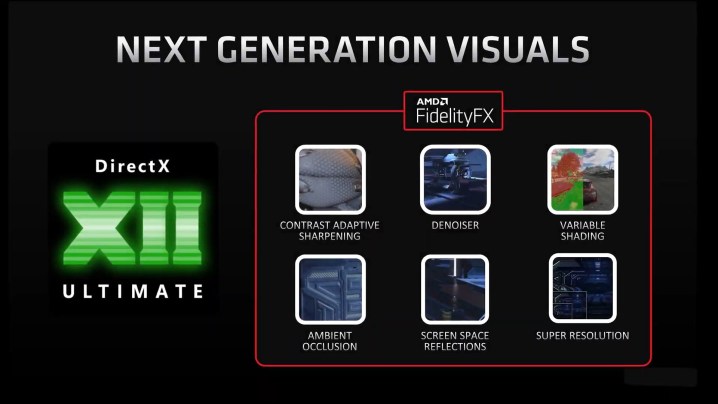AMD’s RX 6000 graphics cards are an inflection point, allowing Team Red to finally scale up and earn some spots in our roundup of the best graphics cards. Powered by the RDNA 2 architecture, these cards come with features like ray tracing and super sampling to power the latest games.
Now that all of the cards are here, we rounded up everything you need to know about the latest from Radeon, including pricing, specs, performance, and a bit about the mobile GPUs.
AMD RX 6000: Price and release date

There are now nearly a dozen RX 6000 GPUs available, with the first cards arriving in November 2020 and the last showing up in May 2022. Here are all of the cards available, as well as their list prices:
- RX 6950 XT — $1,100
- RX 6900 XT — $1,000
- RX 6800 XT — $650
- RX 6800 — $580
- RX 6750 XT — $550
- RX 6700 XT — $480
- RX 6700 — TBA
- RX 6650 XT — $400
- RX 6600 XT — $380
- RX 6600 — $330
- RX 6500 XT — $200
- RX 6400 — $160
Out of the 11 cards in the RX 6000 range, 10 of them are available. The only oddball is the RX 6600 XT, which AMD replaced with the RX 6650 XT. That said, we still found several RX 6600 XT models available, and although AMD won’t continue to produce them, there should be some inventory for a while.
GPU prices have been extremely high, but they’re dropping. And that’s especially true for RX 6000 graphics cards. Although AMD is no longer selling reference models, you can find most third-party cards for their list price. Keep in mind that third-party cards are often a little more expensive than list price. The RX 6700 XT, for example, sells for anywhere from $480 to $600 depending on the model you pick up.
Unlike Nvidia’s RTX 30-series graphics cards, AMD RX 6000 cards are readily available. At the time of writing, we found every model for each card available at list price. The only exception is the RX 6800 XT, which sells for about $100 to $150 above list price.
AMD RX 6000: Specs

AMD has 11 cards in its RX 6000 range, though the RX 6650 XT technically replaces the RX 6600 XT. Compared to Nvidia’s RTX 30-series GPUs, AMD’s cards tend to run at higher clock speeds and offer more memory for mid- to high-end cards. However, RX 6000 cards are more constrained by memory, using GDDR6 memory instead of the GDDR6X featured on Nvidia’s flagship cards.
| Cores | Game clock | Memory | Power draw | Price | |
| RX 6950 XT | 5,120 | 2,100MHz | 16GB GDDR6 | 335W | $1,100 |
| RX 6900 XT | 5,120 | 2,015MHz | 16GB GDDR6 | 300W | $1,000 |
| RX 6800 XT | 4,608 | 2,015MHz | 16GB GDDR6 | 300W | $650 |
| RX 6800 | 3,840 | 1,815MHz | 16GB GDDR6 | 250W | $580 |
| RX 6750 XT | 2,560 | 2,495MHz | 12GB GDDR6 | 250W | $550 |
| RX 6700 XT | 2,560 | 2,424MHz | 12GB GDDR6 | 230W | $480 |
| RX 6700 | 2,304 | 2,174MHz | 10GB GDDR6 | 175W | TBA |
| RX 6650 XT | 2,048 | 2,410MHz | 8GB GDDR6 | 176W | $400 |
| RX 6600 XT | 2,048 | 2,359MHz | 8GB GDDR6 | 160W | $380 |
| RX 6600 | 1,792 | 2,044MHz | 8GB GDDR6 | 132W | $330 |
| RX 6500 XT | 1,024 | 2,610MHz | 4GB GDDR6 | 107W | $200 |
| RX 6400 | 768 | 2,039MHz | 4GB GDDR6 | 53W | $160 |
On the flip side, AMD’s card consumes much less power. Even the RX 6950 XT tops out at 335 watts, which compares to the 450W the RTX 3090 Ti can draw. Overall, AMD’s current-gen offerings are much more efficient, with the RX 6400 sipping down only a measly 50W of power.
The important cards to call out are the RX 6X50 XT refreshes: The RX 6950 XT, RX 6750 XT, and RX 6650 XT. These cards are updated versions of their respective base models, and they carry two differences. Each of the cards features a slight boost in clock speed (up to 4.2% on the RX 6950 XT) and 18Gbps GDDR6 memory, which improves bandwidth.
These newer models don’t offer a significant performance benefit based on our testing, as they carry the same number of cores and the same amount of memory as their respective base models. However, you may find these refreshes more readily available because they launched far after the initial lineup.
AMD RX 6000: Performance

Although AMD’s graphics cards have usually played second fiddle to Nvidia’s, that’s not the case with RX 6000 cards. In many cases, they go toe-to-toe with Nvidia’s best while coming in at a significantly lower price. There are some outliers, however.
The flagship RX 6950 XT was able to hit 68 fps at 4K in Assassin’s Creed Valhalla based on our tests, outpacing Nvidia’s RTX 3090. At 1440p, the RX 6700 XT competes well with the RTX 3070, matching Nvidia’s card in Fortnite with a 121 fps average at 1440p with the Ultra graphics preset.
The lower-end models show some differences. The budget-focused RX 6600 and RX 6600 XT are great for 1080p gaming, though they compete with Nvidia’s RTX 3060. The only bad option out of the range is the RX 6500 XT, which struggles to provide playable frame rates due to severe bottlenecks in the PCIe connection and memory (read our RX 6500 XT review for more).
AMD’s RDNA 2 graphics cards perform great, but they have a big weakness: Ray tracing. Based on our testing, RX 6000 GPUs produce about half of the frame rate of Nvidia’s GPUs when ray tracing is turned on. This comes down to how RX 6000 GPUs are designed, packing in a ray tracing accelerator in each compute unit instead of dedicated ray tracing cores like Nvidia uses.
AMD RX 6000: Laptop GPUs and APUs

AMD started its RX 6000 mobile range with three cards: The RX 6600M, RX 6700M, and RX 6800M. The lineup has grown a lot since then. Here are all of the laptop RX 6000 graphics cards available:
| Compute units | Game clock | Infinity cache | Memory | |
| RX 6850 XT | 40 | 2,463MHz | 96MB | 12GB GDDR6 |
| RX 6800M | 40 | 2,300MHz | 96MB | 12GB GDDR6 |
| RX 6700M | 36 | 2,300MHz | 80MB | 10GB GDDR6 |
| RX 6650M XT | 32 | 2,162MHz | 32MB | 8GB GDDR6 |
| RX 6650M | 28 | 2,222MHz | 32MB | 8GB GDDR6 |
| RX 6600M | 28 | 2,177MHz | 32MB | 8GB GDDR6 |
| RX 6500M | 16 | 2,191MHz | 16MB | 4GB GDDR6 |
| RX 6300M | 12 | 1,515MHz | 8MB | 2GB GDDR6 |
| RX 6800S | 32 | 1,975MHz | 32MB | 8GB GDDR6 |
| RX 6700S | 28 | 1,890MHz | 32MB | 8GB GDDR6 |
| RX 6600S | 28 | 1,881MHz | 32MB | 4GB GDDR6 |
We had a chance to test the flagship RX 6800M. AMD claimed that it could beat the mobile RTX 3080 in games like Assassin’s Creed Valhalla and Resident Evil: Village, but the results are a little more complicated. The RX 6800M can indeed beat Nvidia’s best in games optimized for RDNA2, but it can struggle in certain configurations based on our testing.
AMD also offers its RX 6000S graphics cards, which aren’t quite as powerful as their M-series counterparts. They match the specs, but these GPUs are designed for thin and light laptops.
In addition to discrete cards, AMD has put its RDNA 2 architecture to use in Ryzen 6000 integrated graphics. Although integrated graphics will never match discrete, the power of RDNA 2 helps Ryzen 6000 laptops hit playable frame rates without a dedicated GPU, at least in less demanding games.
AMD RX 6000: Ray tracing and FidelityFX features

With RDNA2, AMD now offers fully hardware-accelerated ray tracing, though it does it in a slightly different fashion to Nvidia. It doesn’t have dedicated RT cores like RTX 20- and 30-series cards, but incorporates a ray accelerator into the standard Radeon compute units.
AMD also expanded its library of FidelityFX features to work hand-in-hand with ray-tracing compute and shader effects to bring better visual fidelity to games. Denoiser and variable rate shading algorithms help to adapt image quality based upon luminance and motion, and a suite of compute-based effects is also available to developers.
One of those effects is FidelityFX Super Resolution (FSR). FSR is a supersampling technique that can increase performance without a significant loss in image quality. It works by feeding an algorithm with a low-resolution internal render. The algorithm then takes that information and expands the pixels into a larger grid, leading to what looks like a high-resolution image.
We’re now on FSR 2.0, which goes toe-to-toe with Nvidia’s Deep Learning Super Sampling (DLSS). Although FSR is a feature of RX 6000 graphics cards, the feature isn’t exclusive to them. FSR works on Nvidia and AMD GPUs going back to 2016.




